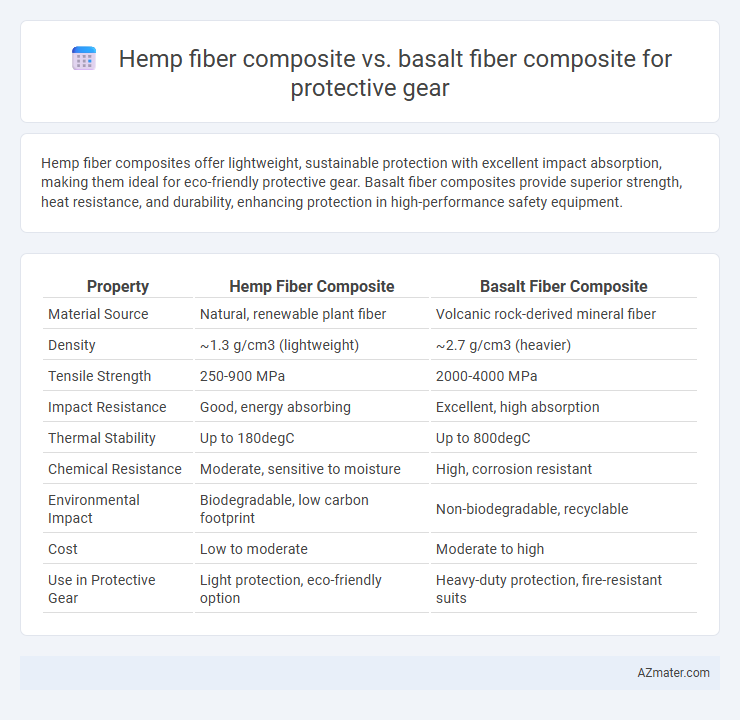Hemp fiber composites offer lightweight, sustainable protection with excellent impact absorption, making them ideal for eco-friendly protective gear. Basalt fiber composites provide superior strength, heat resistance, and durability, enhancing protection in high-performance safety equipment.
Table of Comparison
| Property | Hemp Fiber Composite | Basalt Fiber Composite |
|---|---|---|
| Material Source | Natural, renewable plant fiber | Volcanic rock-derived mineral fiber |
| Density | ~1.3 g/cm3 (lightweight) | ~2.7 g/cm3 (heavier) |
| Tensile Strength | 250-900 MPa | 2000-4000 MPa |
| Impact Resistance | Good, energy absorbing | Excellent, high absorption |
| Thermal Stability | Up to 180degC | Up to 800degC |
| Chemical Resistance | Moderate, sensitive to moisture | High, corrosion resistant |
| Environmental Impact | Biodegradable, low carbon footprint | Non-biodegradable, recyclable |
| Cost | Low to moderate | Moderate to high |
| Use in Protective Gear | Light protection, eco-friendly option | Heavy-duty protection, fire-resistant suits |
Introduction to Protective Gear Materials
Hemp fiber composites offer lightweight, renewable, and biodegradable options with good impact resistance for protective gear, making them an eco-friendly alternative to traditional materials. Basalt fiber composites provide superior mechanical strength, thermal stability, and excellent resistance to wear and chemical degradation, enhancing durability in extreme conditions. Both materials contribute to advanced protective gear design by balancing performance, sustainability, and cost-effectiveness in demanding environments.
Overview of Hemp Fiber Composite
Hemp fiber composite offers a sustainable and lightweight alternative with excellent tensile strength and impact resistance, making it ideal for protective gear applications. Its natural fibers provide superior shock absorption and flexibility compared to synthetic options, contributing to enhanced comfort and durability. Hemp composites also demonstrate good biodegradability and lower environmental impact, supporting eco-friendly protective equipment development.
Overview of Basalt Fiber Composite
Basalt fiber composites are derived from natural volcanic rock, offering exceptional mechanical strength, heat resistance, and durability, making them ideal for protective gear applications such as body armor and helmets. These composites exhibit superior impact resistance and thermal stability compared to traditional materials, enhancing safety and performance in extreme conditions. Their eco-friendly production process also contributes to sustainability goals without compromising protective qualities.
Mechanical Strength Comparison
Hemp fiber composites exhibit tensile strengths ranging from 250 to 550 MPa, offering lightweight and sustainable reinforcement for protective gear. Basalt fiber composites outperform hemp with tensile strengths typically between 1,000 and 3,100 MPa, providing superior impact resistance and durability. The higher mechanical performance of basalt fiber composites makes them more suitable for high-stress protective applications requiring enhanced strength and longevity.
Impact Resistance and Durability
Hemp fiber composites offer excellent impact resistance due to their high tensile strength and natural flexibility, making them effective in absorbing and dissipating energy during collisions. Basalt fiber composites outperform hemp in durability, exhibiting superior resistance to abrasion, chemical exposure, and environmental degradation, which extends the lifespan of protective gear. Combining both fibers can optimize protective gear by balancing hemp's energy absorption with basalt's long-term strength and resilience.
Weight and Flexibility Analysis
Hemp fiber composites exhibit superior lightweight properties compared to basalt fiber composites, making them ideal for protective gear requiring enhanced mobility and reduced wearer fatigue. Flexibility analysis reveals hemp fibers provide greater elongation at break and impact resilience, contributing to improved comfort and adaptability under dynamic conditions. Basalt fiber composites, while offering higher tensile strength, tend to be stiffer and heavier, potentially limiting flexibility and increasing overall gear weight.
Thermal and Chemical Resistance
Hemp fiber composites exhibit moderate thermal resistance with decomposition temperatures around 200-230degC, making them suitable for lightweight protective gear but less ideal for extreme heat exposure. Basalt fiber composites offer superior thermal stability, maintaining integrity above 800degC, which enhances their effectiveness in high-temperature protective applications. Chemically, hemp fibers are vulnerable to moisture and alkalis unless treated, whereas basalt fibers demonstrate excellent chemical resistance against acids, alkalis, and solvents, ensuring better durability in harsh environments.
Environmental Sustainability
Hemp fiber composites exhibit superior environmental sustainability compared to basalt fiber composites due to their biodegradability, lower carbon footprint, and renewable cultivation, which reduces soil degradation and water usage. Basalt fiber composites, while offering high strength and durability, rely on energy-intensive mining and processing of volcanic rock, resulting in greater CO2 emissions. The renewable nature and carbon sequestration capabilities of hemp fibers make them a preferable choice for eco-friendly protective gear applications.
Cost and Manufacturing Efficiency
Hemp fiber composite offers a cost-effective solution for protective gear due to its low raw material price and simpler processing requirements compared to basalt fiber composite. Basalt fiber composite, while generally more expensive, provides superior thermal resistance and strength but involves more energy-intensive manufacturing techniques, impacting overall production efficiency. Selecting hemp fiber composites can significantly reduce production costs and speed up manufacturing cycles, making it advantageous for budget-sensitive protective gear applications.
Application Suitability for Protective Gear
Hemp fiber composites offer excellent impact absorption and lightweight properties, making them suitable for protective gear such as helmets and body armor that require flexibility and comfort. Basalt fiber composites provide superior mechanical strength, thermal resistance, and durability, ideal for high-performance protective equipment in extreme conditions like ballistic vests and industrial safety gear. The choice depends on prioritizing either eco-friendly, lightweight protection or high-strength, heat-resistant applications.

Infographic: Hemp fiber composite vs Basalt fiber composite for Protective gear
 azmater.com
azmater.com